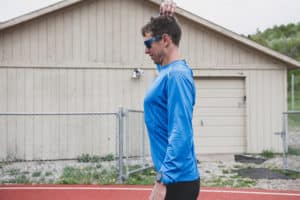Run Quietly

Stand beside a road sometime and watch a race instead of running it. You will see in the passing parade what you might not have noticed from the middle of it, focusing only on yourself and the runners within sight. If you wouldn’t have been one of the lead runners (let’s be honest, most of us aren’t), you’ll now see how wide the gap is between their pace and where yours would have put you. You’ll notice also how different the frontrunners look than most of those in your group.
The faster folks typically run smoother, quieter, taller and prouder. The slower ones pound the ground harder, and slump forward more and stare at their feet. The differences in pace dictate some of the differences in appearance, but this doesn’t have to be so. Slow runners may never be able to keep up with the fast but can look more like them.
I don’t need to watch a race to see these contrasts in action. I view them daily around Bristol or London, where I’m part of the parade but still can observe it in a leisurely way. The roads and parks bring together some of the nation’s fastest runners with many of the slowest.
As they pass me, I see the faster ones gliding over the surface, brushing it quickly and quietly with each footfall. They run proudly, with back straight and eyes forward. Faster running almost demands that they carry themselves this way. Slower pace doesn’t make such demands, and bad habits can take root in these runs. Many of the city runners, with their hunched backs and downcast eyes and scraping footplants, run as if slightly embarrassed to be seen here.
Pace and experience place me somewhere between the groups, but I still try to model myself after the first. Faster runners hold up a picture of what the best running form can and should be at any pace. Slower runners naturally take shorter and lower strides, but we still can model ourselves after those who look the best. This isn’t just advice about looking pretty since running isn’t a beauty contest and no style-points are awarded.

Running head position – think good posture, stand tall and proud!
If form were purely an aesthetic concern, I wouldn’t bother writing about it here. It’s worth mentioning because running lightly over the ground, in good head-to-toe alignment, is easier on the body than landing heavily and out of balance, a thousand times every mile. It’s also a little faster for the same level of effort.
The habits learned here transfer back to your normal running. In all runs, fastest to slowest, check your form with two tests:
1. Where do you look? The back follows the lead of the head. If you watch your feet hit the ground, you’re hunched over. But if you raise your eyes to the horizon, your back naturally straightens and you come into more efficient alignment. Good running is straight-backed, tall running.
2. What do you hear? The feet announce how well you absorb shock. If you hear slap-slip-scrape-shuffle, you’re hitting the ground too hard by not making full use of ankle-flex and toe-off. The less you hear at footplant, the less likely the ground is to hurt you. Good running is springy-stepped, quiet running. Maybe try running a mile here or there in just your socks. It will help you understand where your body is absorbing impact.
Whatever your pace, run softly and run tall. Look like you’re quietly proud of what you’re doing.
Running Loose
You run mostly with the legs. But that doesn’t mean the upper body just goes along for a free and easy ride. What happens above the waist determines how well-balanced and relaxed your running looks and feels. Check yourself these four ways:
— Hands lightly cupped with fingers brushing the palms, not tightly clenched or straight-fingered; wrists relaxed but not flopping. RELAXED
— Arms swinging between the waistband and the lower chest, not higher or lower; swinging somewhat across the body but not past the midline; elbows flexing slightly, around 90 degrees. STRONG
— Shoulders low and loose, not high and tight; riding level, not dipping from side to side, or with one shoulder higher than the other. BALANCED
— Face with the jaw relaxed, not clenched in a grimace; eyes gazing forward, not down at the feet.
Send us a message or leave a comment and let us know if you have any questions! We all have our own thoughts on the matter, and we all have something different that suits us.
See what’s up next week for our #RunFormFriday tip! For a more in-depth understanding of how to put this into practice, get in touch and we’ll see how we can help!
